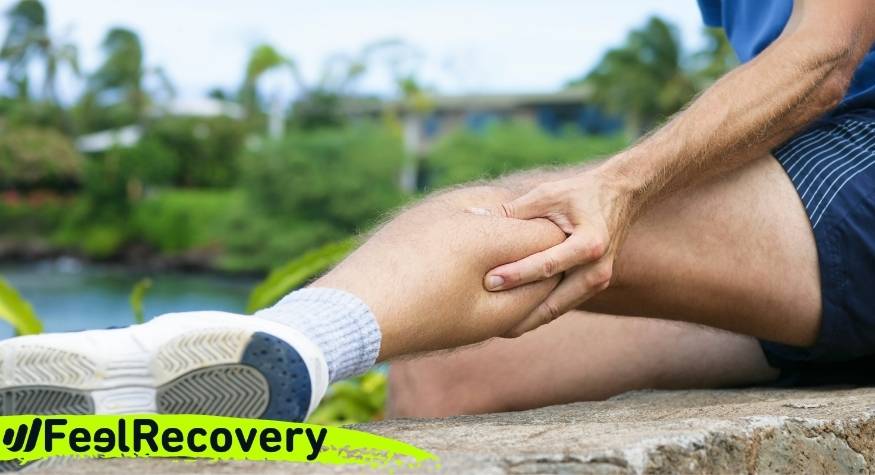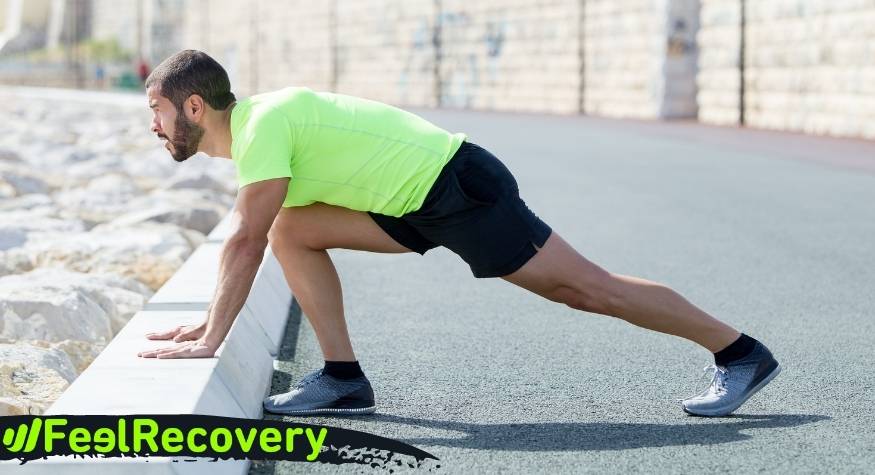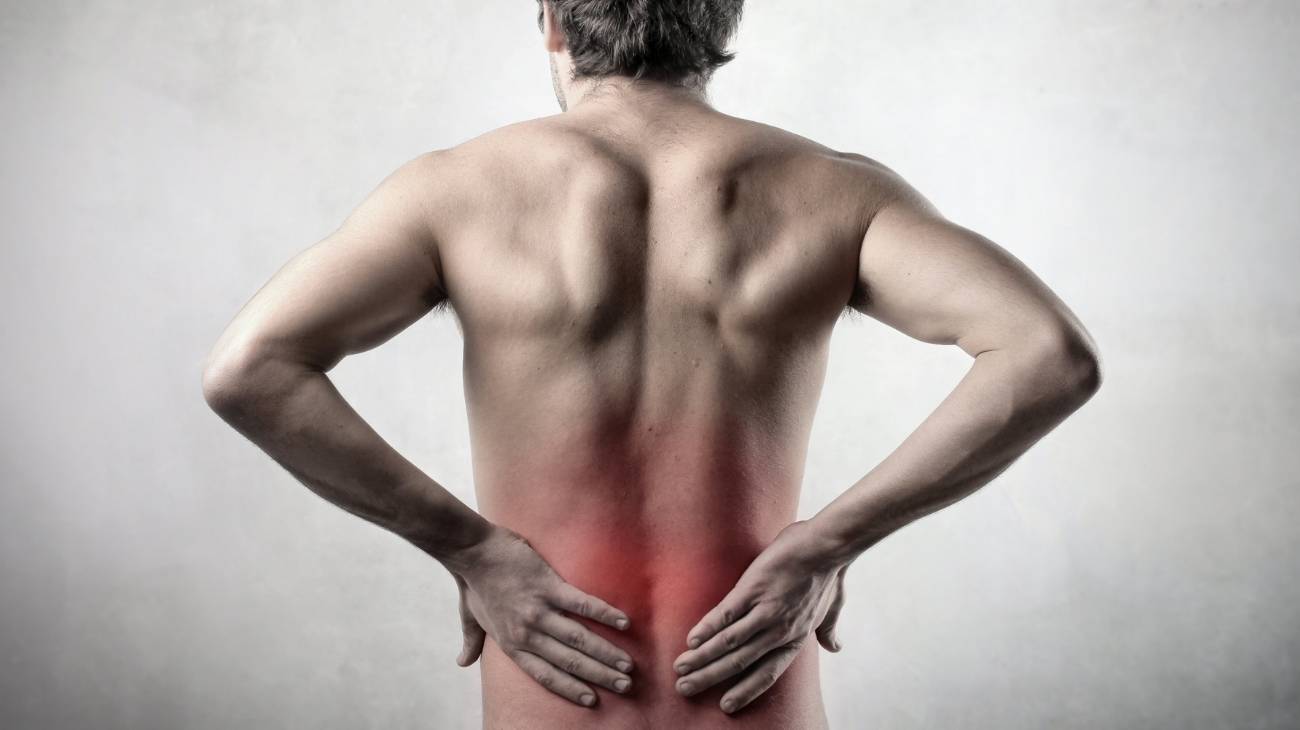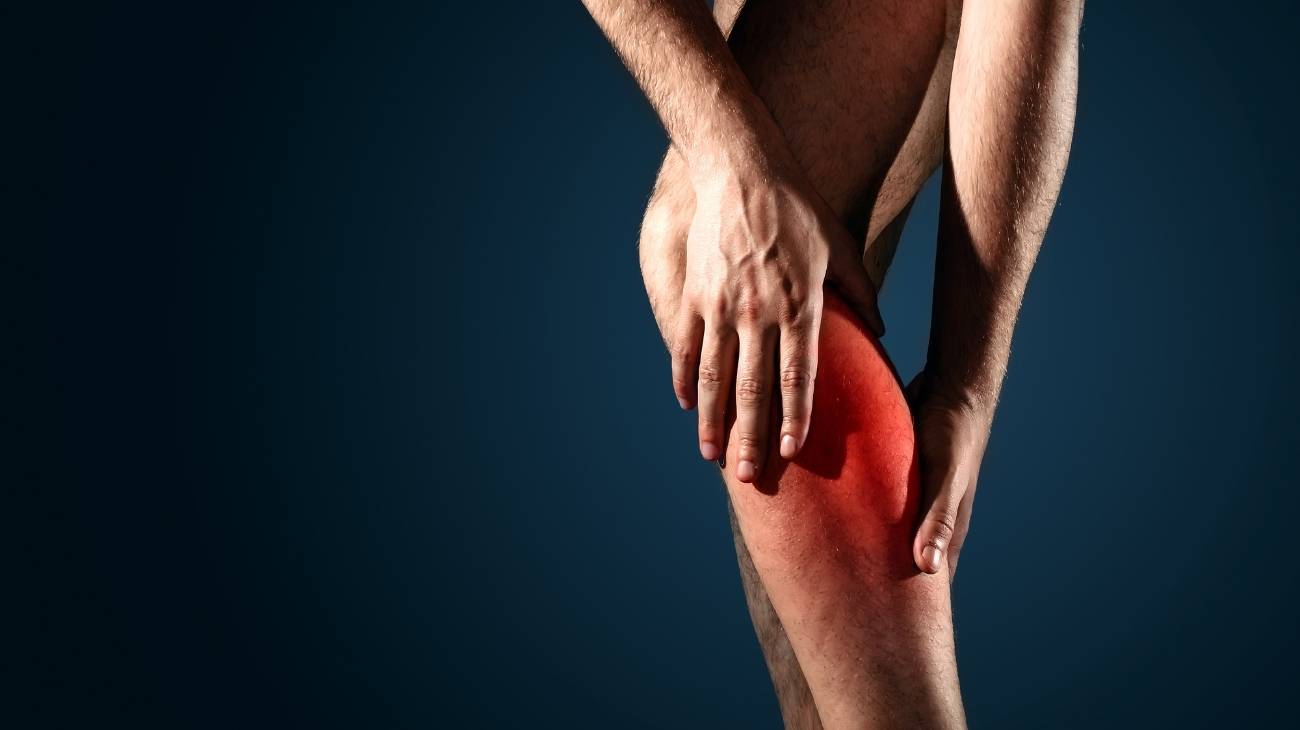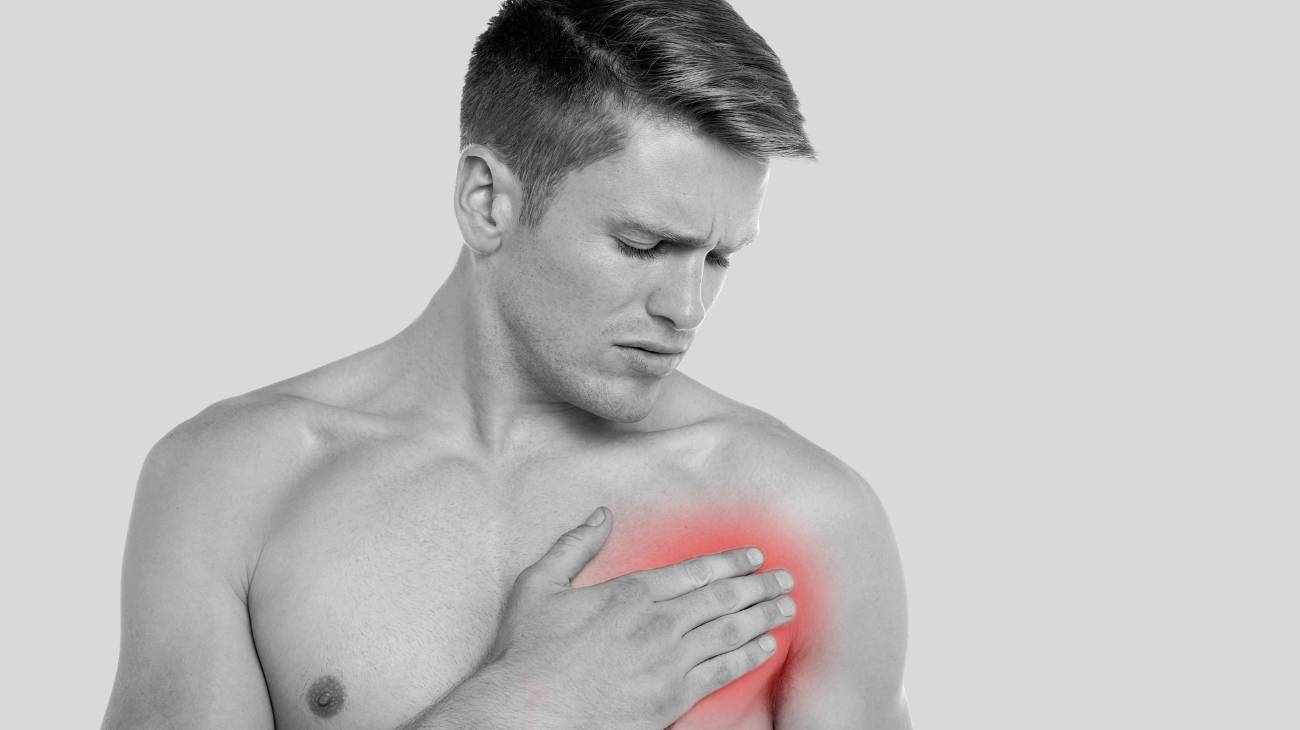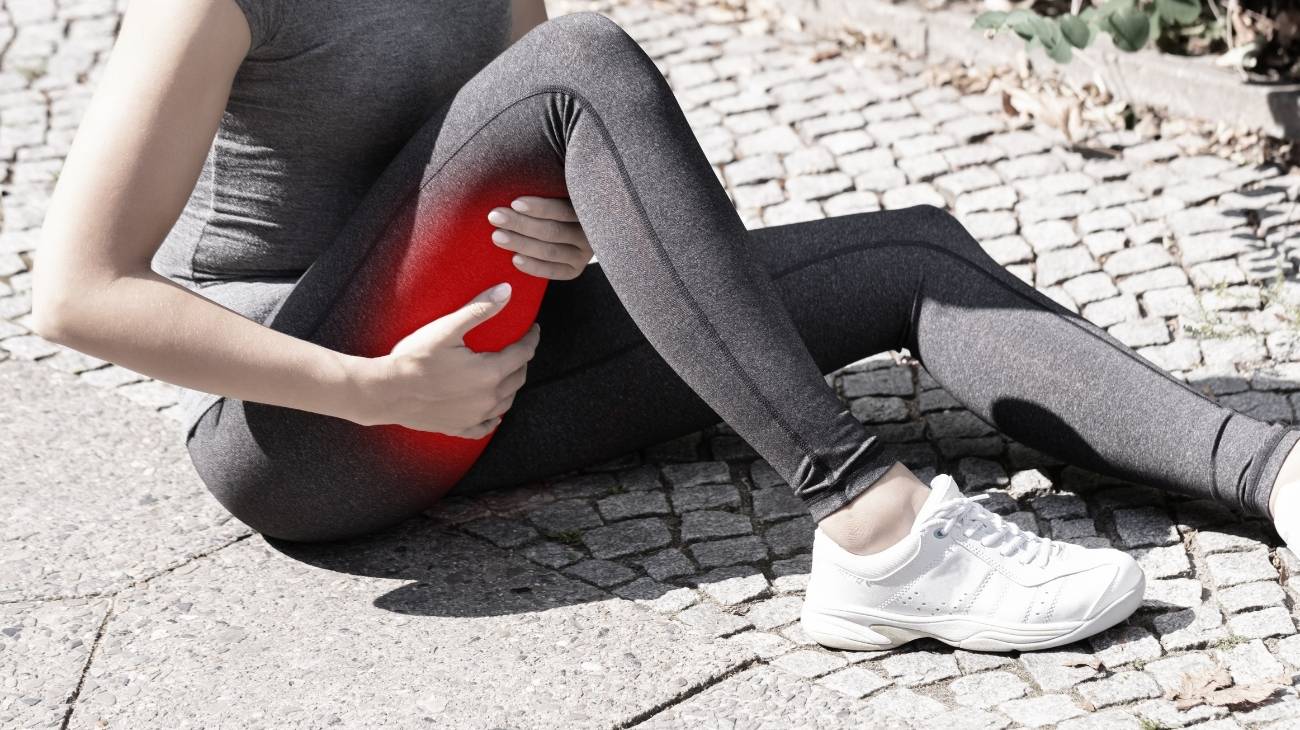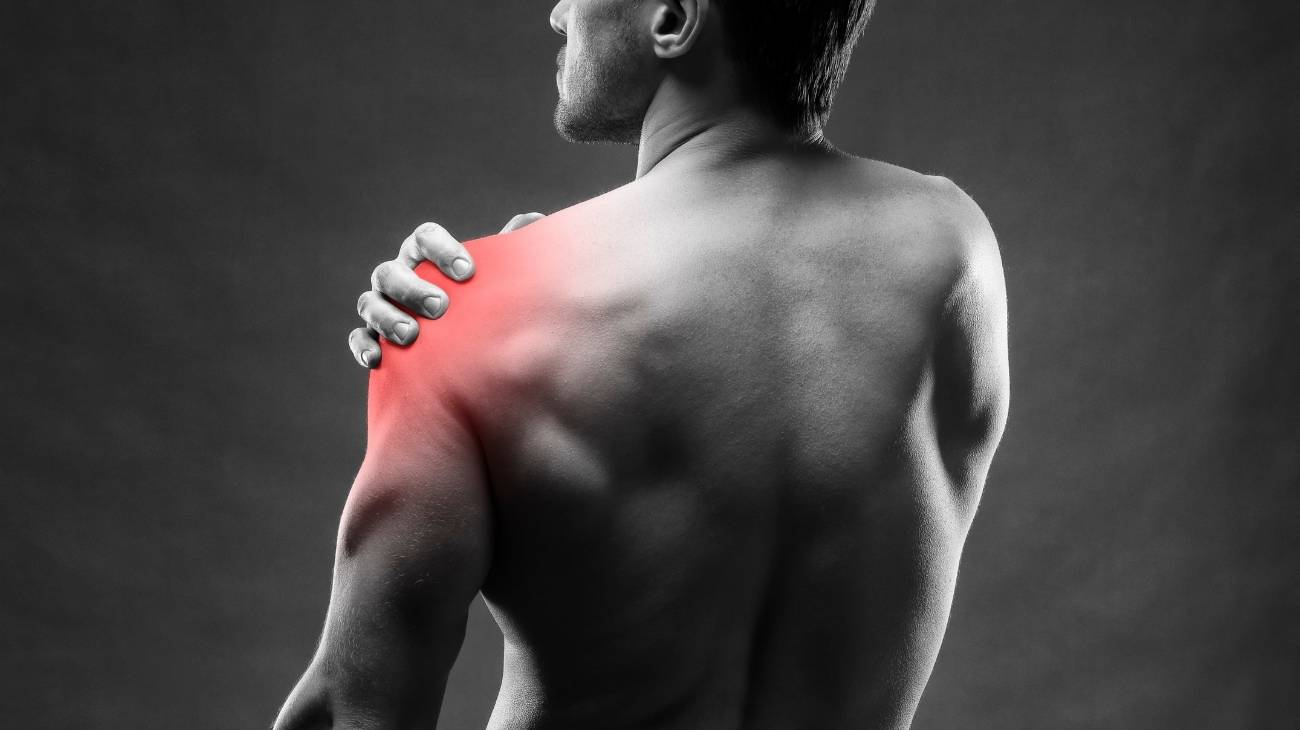- What are leg muscle strains?
- What are the causes of muscle strains in the legs?
- Best products for leg strains
- Main symptoms associated with muscle strains in the thighs and legs
- How to relieve the pain and improve the symptoms of muscle strains in the legs?
- What are the most effective methods of prevention for muscle pulls in the thighs and legs?
The thighs and buttocks are prone to receive lessons for different reasons, and can suffer a muscle strain that can affect the mobility of the person and cause pain and inflammation in the area. These strains are known as muscle strains of the legs, calves and thighs, but if you want to know what they are, we invite you to read on.
You will find all the information related to the causes of this ailment and the main symptoms that appear when there is an involuntary tension of the tissues. Don't miss anything because we will also give you the best tips to avoid this ailment and alleviate the pain.
What are leg muscle strains?
Leg muscle strains are inflammatory lesions that are caused by involuntary tension in the muscular structure located in this area of the body. This is due to the difficulty of the bloodstream to exchange gases and fluids with the muscle fibres.
In the absence of this type of action by the blood, metabolic molecules remain in the fibres causing waste to accumulate considerably in this area. This forces the nervous system to issue warning signals by means of pain and tension focused on the thighs and buttocks. In some cases the contracture can reach the psoas iliacus, deep multifidus and quadratus lumborum.
What are the causes of muscle strains in the legs?
To avoid muscle pulls in the legs and thighs, it is necessary to know the factors that cause this ailment.
For this reason, we will show you each of them below
- Lack of rest: One of the most recurrent factors or causes of these types of injuries is the lack of muscle rest. This happens mainly in athletes and in people who have to work constantly with their legs and thighs.
- Obesity: Overweight is another of the most common causes of pulled muscles in the legs. This is caused by the great effort made by the muscles to support all the weight.
- Sedentary lifestyle: The lack of exercise in the muscles causes them to remain in one position and tension, so that every time you need to perform an activity the muscle structure is not prepared, poor diet and lack of hydration can also cause this type of injury.
- Anxiety and anxiety: Stress is a symptom that is frequently present in a high percentage of people who suffer from leg contractures. This is due to the large amount of waste molecules that remain in the tissues.
- Older age: Older people suffer from loss of elasticity in the muscle structure. This means that the chances of contracting a strain increase significantly.
- Low levels of micronutrients: B vitamins, magnesium, sodium, calcium and potassium are some necessary elements that should be present in people's bodies. These nutrients help to maintain the correct elasticity of the muscles, so a lack of them can lead to pulled thighs and buttocks.
- High-intensity activities: These causes not only appear in athletes, but also in all those who have to work lifting heavy objects demanding muscle tension in the legs and buttocks.
- Lack of warm-up and stretching: This cause is somewhat related to the previous point. Before practising any activity, whether it is demanding or not, it is necessary to start with gradual exercises that prepare the muscular system for the actions. In addition, stretching is essential to avoid tight muscles in the buttocks and thighs.
- Low temperatures: Cold is a silent cause of muscle strains in the legs. This is because the body unconsciously contracts the entire muscle structure as a sign of self-protection.
Best products for leg strains
Bestseller
-
2 Calf Compression Sleeve (Black/Gray)
$19.95 -
2 Calf Compression Sleeve (Green/Navy)
$19.95 -
2 Calf Compression Sleeve (Pink/Bordeaux)
$19.95 -
2 Knee Compression Sleeve (Black/Gray)
$19.95 -
2 Knee Compression Sleeve (Green/Navy)
$19.95 -
2 Knee Compression Sleeve (Pink/Bordeaux)
$19.95 -
2 Patella Knee Strap (Black/Gray)
$14.95 -
2 Patella Knee Strap (Green/Navy)
$14.95 -
2 Patella Knee Strap (Pink/Bordeaux)
$14.95 -
2 Thigh Compression Sleeve (Black/Gray)
$19.95 -
2 Thigh Compression Sleeve (Green/Navy)
$19.95 -
2 Thigh Compression Sleeve (Pink/Bordeaux)
$19.95 -
Acupressure Mat and Pillow (Black/Gray)
$49.95 -
Acupressure Mat and Pillow (Green/Navy)
$49.95 -
Acupressure Mat and Pillow (Pink/Bordeaux)
$49.95 -
Acupressure Pillow (Black/Gray)
$29.46 -
Acupressure Pillow (Green/Navy)
$29.46 -
Acupressure Pillow (Pink/Bordeaux)
$29.46 -
Heating Pad for Microwave Classic Bottle Shaped (Hearts)
$19.95 -
Heating Pad for Microwave Classic Bottle Shaped (Oxford)
$19.95 -
Heating Pad for Microwave Classic Bottle Shaped (Sport)
$19.95 -
High Density Foam Roller for Muscle (Black/Gray)
$29.95 -
High Density Foam Roller for Muscle (Green/Navy)
$29.95 -
High Density Foam Roller for Muscle (Pink/Bordeaux)
$29.95 -
Ice Massage Roller Ball (Black)
$39.95 -
Ice Massage Roller Ball (Green)
$39.95 -
Ice Massage Roller Ball (Pink)
$39.95 -
Microwave Heating Pad for Back Pain Relief (Extra Large) (Hearts)
$29.95 -
Microwave Heating Pad for Back Pain Relief (Extra Large) (Oxford)
$29.95 -
Microwave Heating Pad for Back Pain Relief (Extra Large) (Sport)
$29.95 -
Microwaveable Heating Pad for Pain Relief (Hearts)
$19.95 -
Microwaveable Heating Pad for Pain Relief (Oxford)
$19.95 -
Microwaveable Heating Pad for Pain Relief (Sport)
$19.95 -
Pack 2 In 1 Foam Roller High + Soft Density (Black/Gray)
$29.95 -
Pack 2 In 1 Foam Roller High + Soft Density (Green/Navy)
$29.95 -
Pack 2 In 1 Foam Roller High + Soft Density (Pink/Bordeaux)
$29.95 -
Soft Density Foam Roller for Recovery (Black)
$29.95 -
Soft Density Foam Roller for Recovery (Green)
$29.95 -
Soft Density Foam Roller for Recovery (Pink)
$29.95 -
Sport Compression Socks (1 Pair) (Black/Gray)
$19.95 -
Sport Compression Socks (1 Pair) (Green/Navy)
$19.95 -
Sport Compression Socks (1 Pair) (Pink/Bordeaux)
$19.95 -
Trigger Point Massage Stick (Black)
$14.95 -
Trigger Point Massage Stick (Green)
$14.95 -
Trigger Point Massage Stick (Pink)
$14.95
Main symptoms associated with muscle strains in the thighs and legs
See below what are the main signs that are associated with gluteal and thigh muscle strain
- Pain in the quadriceps and hamstring: In some cases a pull in the thighs can cause pain in this part of the leg, which can go as far as the knee.
- Limitation of movement: Muscle strains that occur in this area cause the person to be unable to bend, sit, stand or turn on their own axis due to the pain they perceive.
- "False" sciatica: A muscle contracture generated in the piriformis muscle can cause piriformis syndrome, which consists of pain and tingling that can spread to the lower back and be mistaken for a sciatic ailment.
- Prickling: The sensation of being pricked by a needle in a specific place, especially when you want to perform a new action, can be a warning symptom of a pulled muscle in the legs and thighs.
- Numbness: Lack of proper blood supply and allocation causes a tingling sensation in the buttock and back of the leg.
- Swelling: You are likely to find the affected area with some swelling due to the lack of normal blood circulation to exchange gases and fluids in this area.
How to relieve the pain and improve the symptoms of muscle strains in the legs?
The pain in the legs and muscles as well as the symptoms that are produced by cramps in this part of the body can be reduced thanks to the application of some of the treatments that we will show you in the following paragraphs.
Alternative and complementary therapies
Complementary treatments and therapies are techniques that are used in an auxiliary way to reduce the symptoms of muscle contractions that occur in the legs and thighs.
Get to know the most important ones in detail
- Hot and cold therapy: While it is true that cold contracts the muscles of the legs and thighs, an application can be efficient if the ideal temperature is used. For this reason, the session should last around 15 minutes and should start with heat, continue with cold temperature and finally finish with warm elements. This will provide an ideal combination so that the muscle fibres receive the benefits of this therapy in an internal superficial way. Thus, it is possible to decrease inflammation and improve the blood supply so that the capillary walls function properly in the affected area.
- Compression therapy: It is possible to apply thigh wraps and other types of bandages with ideal pressure to achieve containment of the muscular structure of this area. This will help the blood to begin to circulate normally through the tissues and to exchange oxygen and nutrients with the muscle fibres. As a result, the pain will begin to subside and the symptoms of swelling and stiffness will improve. In addition, compression clothing helps to keep the muscle relaxed.
- Massage therapy: It is feasible to apply massage therapy to the legs and thighs to reduce swelling and obtain more range of motion. Through this treatment, arterioles and venules are stimulated to cause the blood vessels to dilate and generate more blood flow. This will help the muscle fibres to receive more nutrients, leading to remission of the disease in a short period of time.
- Acupressure therapy: This type of medicine aims to help the patient relax and find a psychological balance to cope with the disease and their daily life. For this reason, acupressure is an efficient treatment when the aim is to reduce the patient's stress. This will help to relax the area of the legs and thighs, achieving and improving the symptoms of muscular strain.
- Thermotherapy: One of the great benefits of heat is to stimulate the arteries and small veins found in the soft tissues of the legs and thighs. This helps to obtain a better blood supply, as the capillary walls are less at risk of injury. When a better blood flow is achieved in this area, the blood can eliminate metabolites through the exchange of nutrients and oxygen. This reduces inflammation and pain caused by muscle strain.
- Natural remedies using plants: To reduce the inflammation and pain of pulled muscles in the legs and thighs, it is possible to use an alternative treatment using natural plants. Within this botanical group, the most commonly used are mint, laurel, basil, linden and chamomile, among others. The procedure is very simple, it can be applied by means of a warm bath or by ingesting infusions with these plants that have calming and relaxing effects. It is advisable to consult a doctor before choosing this complementary treatment to avoid future injuries.
- Healthy lifestyle habits: The aim of this type of complementary treatment is to get the patient to incorporate different habits that will help to avoid future injuries to the thighs and legs. This will not only improve the symptoms of the current pulled muscle, but will also help the person to include lifestyle habits that contribute to overall health. Therefore, the doctor will address a series of recommendations that will be aimed at muscle rest, stress reduction, a healthy diet and a type of exercise according to the patient's characteristics.
Nutritional supplements
It is feasible that the pull generated in the legs and thighs could have been caused by a lack of nutrients in the patient's body. To solve this problem, the doctor may prescribe, under his supervision, the incorporation of potassium, magnesium, calcium and vitamins into the diet.
This will help to keep the soft tissues in the correct tension and relaxed, which will prevent the muscles from maintaining an involuntary stiffness that could lead to a new muscle strain.
Physiotherapy treatments
To stimulate the arterioles and venules that form the blood vessels located in the tissues of the legs and thighs, the application of heat is necessary. This helps to improve the bloodstream so that metabolites are eliminated when gases and nutrients are exchanged between the blood and the muscles.
There are different techniques that can be used by the physiotherapist, the most common being thermotherapy, hydrotherapy and electrotherapy. It should not be forgotten that massages must be carried out by a professional, otherwise muscle injuries may increase.
Medicines
The first thing to know is that in order to treat the symptoms of a muscle strain in the legs and thighs , it is necessary to go to the doctor so that he/she can prescribe and monitor the pharmacological therapy. This means that self-medication should never be practised, due to the complications that can arise from inappropriate medication without specialised control.
What are the most effective methods of prevention for muscle pulls in the thighs and legs?
Find out all the tips you should take into account when it comes to preventing the onset of leg, calf and thigh muscle pulls
- Perform the activities with the correct posture: This will prevent the buttocks and legs from being overexerted to perform the activity. This means that involuntary tensions will not appear in this part of the body, thus reducing the likelihood of injury.
- Don't do too strenuous tasks: Avoid all jobs or activities in which you will have to put maximum strain on your glutes and thighs. This will help you avoid the accumulation of metabolites in the fibres.
- Get enough rest: Don't forget that muscle rest helps to prevent contractures, so getting enough sleep and rest when doing chores is a good starting point to avoid muscle pulls.
- Drink enough water: Hydration will help keep your muscle structure in good shape. In addition, you should accompany your activities with a healthy diet.
- Try not to spend too much time in the cold: Cold temperatures help the appearance of pulled muscles in the thighs and legs. For this reason, it is advisable to protect this area by wearing suitable clothing that protects the soft tissues of the body.
- Reduce stress: By means of relaxation, breathing and meditation techniques, you will be able to find a psychological balance to face everyday problems. This will help to keep the muscles in the area rested.
- Practice low-impact physical activity: A sedentary lifestyle is one of the most important and recurrent causes of this type of injury. Therefore, doing any activity will help you to keep your blood circulation and muscles moving. Don't forget that warming up and stretching your muscles is important before doing these activities.
- Visit your doctor to add nutritional supplements: This way you can incorporate magnesium and potassium, which are necessary for the muscle fibres, into your diet.
References
- Malliaropoulos, N., Papacostas, E., Kiritsi, O., Rad, P. M., Papalada, A., Gougoulias, N., & Maffulli, N. (2010). Posterior thigh muscle injuries in elite track and field athletes. The American journal of sports medicine, 38(9), 1813-1819. https://journals.sagepub.com/doi/abs/10.1177/0363546510366423
- Armfield, D. R., Kim, D. H. M., Towers, J. D., Bradley, J. P., & Robertson, D. D. (2006). Sports-related muscle injury in the lower extremity. Clinics in sports medicine, 25(4), 803-842. https://www.sportsmed.theclinics.com/article/S0278-5919(06)00046-9/fulltext
- Kary, J. M. (2010). Diagnosis and management of quadriceps strains and contusions. Current reviews in musculoskeletal medicine, 3(1-4), 26-31. https://link.springer.com/article/10.1007/s12178-010-9064-5
- Croisier, J. L., Forthomme, B., Namurois, M. H., Vanderthommen, M., & Crielaard, J. M. (2002). Hamstring muscle strain recurrence and strength performance disorders. The American journal of sports medicine, 30(2), 199-203. https://journals.sagepub.com/doi/abs/10.1177/03635465020300020901
- Fousekis, K., Tsepis, E., Poulmedis, P., Athanasopoulos, S., & Vagenas, G. (2011). Intrinsic risk factors of non-contact quadriceps and hamstring strains in soccer: a prospective study of 100 professional players. British journal of sports medicine, 45(9), 709-714. https://bjsm.bmj.com/content/45/9/709.short
- Orchard, J., & Best, T. M. (2002). The management of muscle strain injuries: an early return versus the risk of recurrence. Clinical Journal of Sport Medicine, 12(1), 3-5. https://journals.lww.com/cjsportsmed/fulltext/2002/01000/the_management_of_muscle_strain_injuries__an_early.4.aspx
- Noonan, T. J., & Garrett Jr, W. E. (1999). Muscle strain injury: diagnosis and treatment. JAAOS-Journal of the American Academy of Orthopaedic Surgeons, 7(4), 262-269. https://journals.lww.com/jaaos/Abstract/1999/07000/Muscle_Strain_Injury__Diagnosis_and_Treatment.6.aspx
- Beiner, J. M., & Jokl, P. (2001). Muscle contusion injuries: current treatment options. JAAOS-Journal of the American Academy of Orthopaedic Surgeons, 9(4), 227-237. https://journals.lww.com/jaaos/Abstract/2001/07000/Muscle_Contusion_Injuries__Current_Treatment.2.aspx
- Orchard, J. W., Best, T. M., Mueller-Wohlfahrt, H. W., Hunter, G., Hamilton, B. H., Webborn, N., … & Glasgow, P. (2008). The early management of muscle strains in the elite athlete: best practice in a world with a limited evidence basis. British Journal of Sports Medicine, 42(3), 158-159. https://bjsm.bmj.com/content/42/3/158.short
- Butterfield, T. A. (2010). Eccentric exercise in vivo: strain-induced muscle damage and adaptation in a stable system. Exercise and sport sciences reviews, 38(2), 51-60. https://journals.lww.com/acsm-essr/Fulltext/2010/04000/Stretch_Activated_Ion_Channel_Blockade_Attenuates.00003.aspx






































































